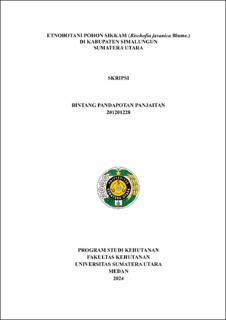Etnobotani Pohon Sikkam (Bischofia javanica Blume.) di Kabupaten Simalungun Sumatera Utara
Ethnobotany of Sikkam Trees (Bischofia javanica Blume.) in Simalungun Regency

Date
2024Author
Panjaitan, Bintang Pandapotan
Advisor(s)
Rambey, Ridahati
Metadata
Show full item recordAbstract
The plant with the latin name B. javanica Blume or known as "Sikkam" is
a plant that has long been known as an ingredient in traditional medicine and a
natural dye for rattan and bamboo weaving. This research was conducted to
determine the use, processing methods, conservation and maintenance of Sikkam
plants by the Simalungun community. The semi-structured interview method is
used to collect data, namely by interviewing selected respondents with several
questions that have been prepared beforehand, then these questions can be
developed to obtain deeper information. Sources are determined using the
"Snowball Sampling" technique or carried out in a series by asking for
information and recommendations for further potential sources from sources who
have been interviewed previously. Vegetation analysis activities in the field are
also carried out using purposive sampling techniques in determining observation
plots. Data resulting from vegetation analysis were analyzed using the Important
Value Index (INP) and Species Diversity Index calculations. Based on the results
of interviews with 33 native respondents in three villages of Simalungun district,
including Sirube-rube Village, Sipolha Harison and Pondok Buluh, 14 uses of
sikkam were used as ingredients for traditional medicine and 10 uses as spices in
traditional dishes. The highest ICS value of medicine is found in the use of
diarrhea medicine with an ICS value of 30%, while the highest use as a spice is
Dayok Nabinatur, 50%. The results of the vegetation analysis show that the
highest important index value for B. javanica Blume is at the tree level, namely 40
trees with a total percent INP of (45.65%).
Collections
- Undergraduate Theses [2147]
